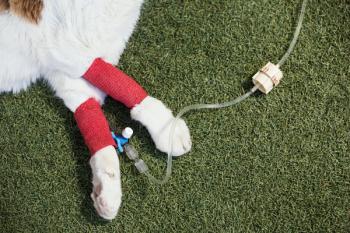
Physical therapists aren't masseuses
Why you should consider adding this highly trained medical professional to your rehabilitation team.
Amie's husband, Tom, had a little chat last summer with a golf buddy whose back was really bothering him.
DAVE: Amie's a physical therapist, right?
TOM: Yeah. She's been practicing for more than 10 years now.
DAVE: So she took classes on the weekends? Took an exam online? My back is killing me. I'll bet she gives a great massage.
Multitalented: Physical therapists can help patients prevent or manage a health condition using a variety of treatment techniques to restore function, reduce pain and prevent disability. (John Block/Getty Images)
Ouch! The truth is that many people do not know that physical therapy is a health profession—not a hobby. The reality is that student physical therapists go through three or more years of postgraduate education and training, and most are now awarded doctorate degrees.
What is a physical therapist?
The American Physical Therapy Association (APTA) recognized the need for educating the public about physical therapy and launched a public relations and marketing campaign called "Move Forward: Physical Therapy Brings Motion to Life." A major goal of this outreach was to let people know what physical therapists do and how they can help people get back in motion and improve the quality of their lives. Its website (
- All physical therapists are required to receive a graduate degree—either a master's or a doctorate. There are 210 academic institutions with professional physical therapist programs, and more than 90 percent offer the DPT degree. (More than 75 percent of all 2008 physical therapy graduates were awarded a DPT degree.)
- Physical therapists take a national licensure examination. State licensure is also required in each state where a physical therapist practices.
- Physical therapists apply research and proven techniques to help improve or restore mobility.
- Physical therapists provide care for people in a variety of settings including hospitals, private practices, outpatient clinics, home health agencies, schools, sports and fitness facilities, work settings and nursing homes.
- Physical therapists diagnose and treat people of all ages including newborns, children and the elderly. They may consult and practice with other health professionals.
- Physical therapists can help patients prevent or manage a health condition using a variety of treatment techniques to restore function, reduce pain and prevent disability.
The evolution of physical therapy
Physical therapy has advanced from "restoration aides" that helped wounded soldiers returning from World War I to a nursing specialty to a clinical doctorate degree program. Even doctoral residencies and fellowships are now an option.
The American Board of Physical Therapy Specialties recognizes eight specialties: pediatrics, geriatrics, women's health, cardiovascular and pulmonary, clinical electrophysiology, neurologic, sports and orthopedics. Certified specialists are expected to build on their education and clinical skills in their particular field and are required to be recertified every 10 years.
Education and training
Professional physical therapy education programs have prerequisites similar to those of veterinary medical schools. Required courses include biology, zoology, anatomy, physiology, organic chemistry, biochemistry, physics, calculus and statistics. Students accepted into a physical therapy program study anatomy, neuroscience, kinesiology, biomechanics, pathology, radiology/imaging and pharmacology. Clinically based courses such as medical screening, diagnostics and outcomes measurement are also part of the curriculum.
Physical therapy students learn how to clinically evaluate patients. They are trained to perform joint mobilization and manipulations, to prescribe functionally based therapeutic exercise and to facilitate healing and recovery through real-world and simulated activities. They learn to use physical modalities such as ultrasonography, lasers, electrotherapy and hydrotherapy. Extensive supervised clinical experience is also provided—an essential part of a physical therapist's education.
Physical therapy and animals
The idea that animals could benefit from physical therapy did not become a reality until the 1960s when equine sporting events became popular and there was an increasing number of injured horses. Interest in veterinary rehabilitation continued to grow in the United States, fueled by demand from Baby Boomers who had seen the benefits of physical therapy for their own injuries and aging joints.
The American Veterinary Medical Association (AVMA) added "veterinary physical therapy" to its guidelines in 1996. There are now 17 U.S. veterinary colleges that offer canine rehabilitation, and several are planning to add student electives and clinical rotations. In 2010, the AVMA recognized the American College of Veterinary Sports Medicine and Rehabilitation as a new specialty organization. Guidelines for residency and training will be available soon.
Three veterinary rehabilitation certification programs exist in the United States—two canine and one equine. The basic requirements are similar—about 15 classroom days with exams, reports and internship opportunities rounding out the curriculum.
The veterinarian-physical therapist partnership
Veterinary rehabilitation can be profitable—even in challenging economic times—if you do your homework and create a viable business plan. Take a look at your budget, space and location. Consider staffing requirements, including the need for certified rehabilitation therapists. Think about what equipment you will need and how will you pay for it. Also consider what you think the demand will be for rehabilitation services from your existing clients and how will you attract new clients.
Let's say that all of your planning has paid off, and you have reached the point where you have a trained and committed staff and state-of-the-art equipment. Your client base is growing, but now there are other practices in the area starting to offer rehabilitation services. How do you maintain your competitive edge? One answer is to add a physical therapist.
To start, investigate the veterinary and physical therapy practice acts in your state. Ultimately, they have the final say in what kind of relationship a veterinarian can have with a physical therapist. Also check your practice's liability insurance to determine what coverage a physical therapist should have to protect all parties. Before you consider adding any candidate to your rehabilitation team, make sure he or she is licensed as a physical therapist and is either certified or pursuing certification in veterinary rehabilitation.
There are a number of ways—some traditional and some creative—to incorporate a physical therapist in your rehabilitation practice.
- Employment. You have the space and demand for rehabilitation services to justify adding a physical therapist to your staff on a full-time, part-time or hourly basis—either salaried or paid on commission or on production.
- Contract employment. You want to add a physical therapist to your team but are not in a position to add staff. The physical therapist could be reimbursed strictly based on services provided, with your practice being responsible for management and expenses.
- Consultant. Your rehabilitation practice is doing well, but you are still not ready to add another employee. You have challenging and unusual cases, and there are times when you would like to have another professional see these patients. A physical therapist acting as a consultant could perform evaluations at your practice and make recommendations for further interventions.
- Referral. You want to maintain management of a particular case but think that a second opinion would be worthwhile. There is a physical therapist in your area (or even farther away) that you know and trust, and you recommend that your clients take their pets directly to this person for a consultation, state laws permitting.
- Sublease. You are contacted by a physical therapist who has an existing practice—most likely home-based or using a home health model—and is interested in subletting space, equipment and maybe even your support staff. This arrangement has the potential to be beneficial for both parties.
In conclusion
We hope you now have a better idea of what physical therapy is all about and why you should consider adding rehabilitation to your practice. Now, for an APTA-approved version of that earlier conversation on the golf course:
DAVE: Amie's a physical therapist, right?
TOM: Yeah. She's been practicing for more than 10 years now. She has an advanced degree in physical therapy and is certified as a canine rehabilitation therapist.
DAVE: Wow, that's impressive. I have barely been able to make it through 18 holes of golf this summer because my back hurts so much. I'll bet Amie could help me. And my dog's been limping. Could she take a look at him, too?
Lamoreaux Hesbach is the president of the Animal Rehabilitation Special Interest Group. Dr. Van Dyke is the founder and CEO of the Canine Rehabilitation Institute in Wellington, Fla., with locations in Fort Collins, Colo., and Annapolis Junction, Md.
Newsletter
From exam room tips to practice management insights, get trusted veterinary news delivered straight to your inbox—subscribe to dvm360.



